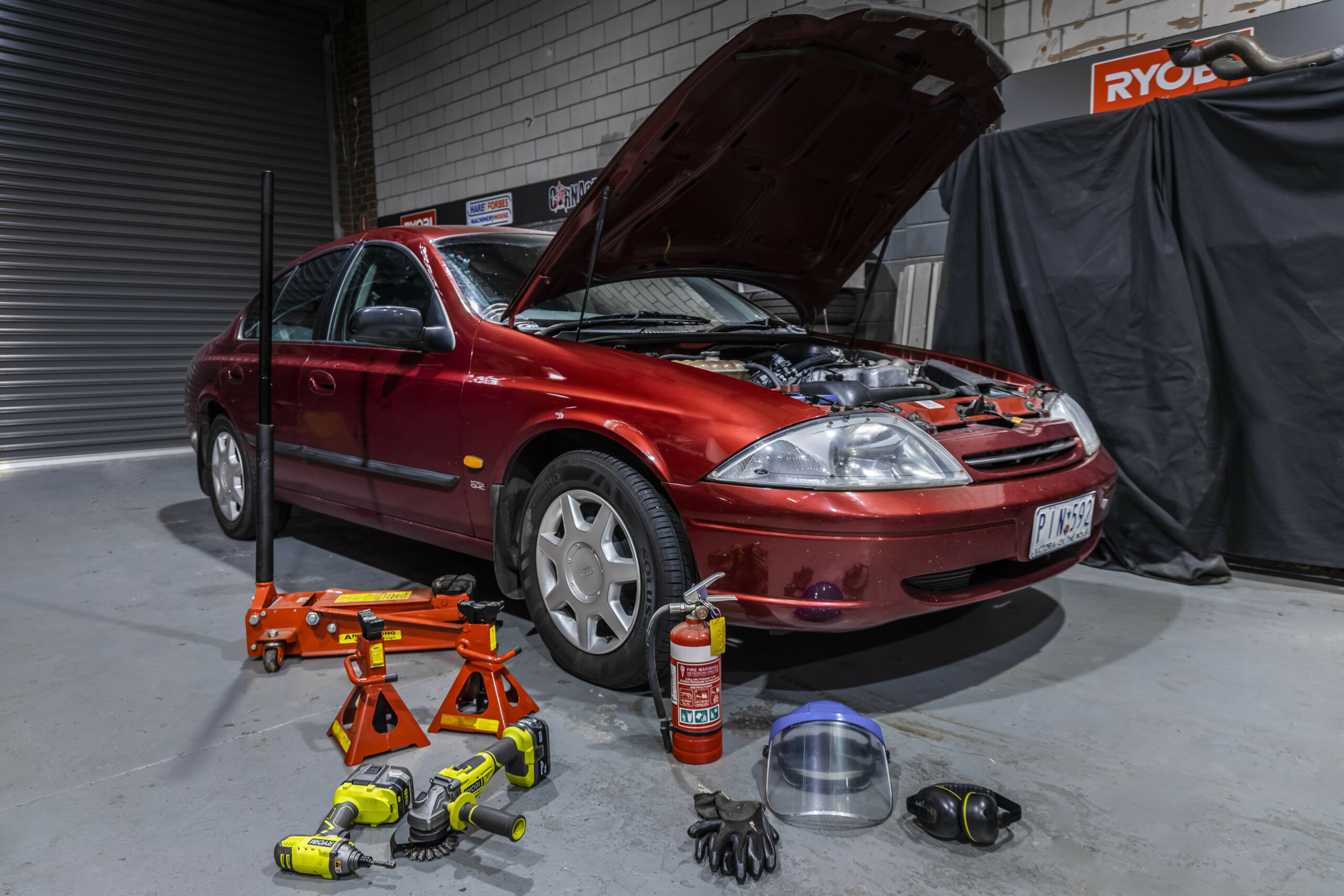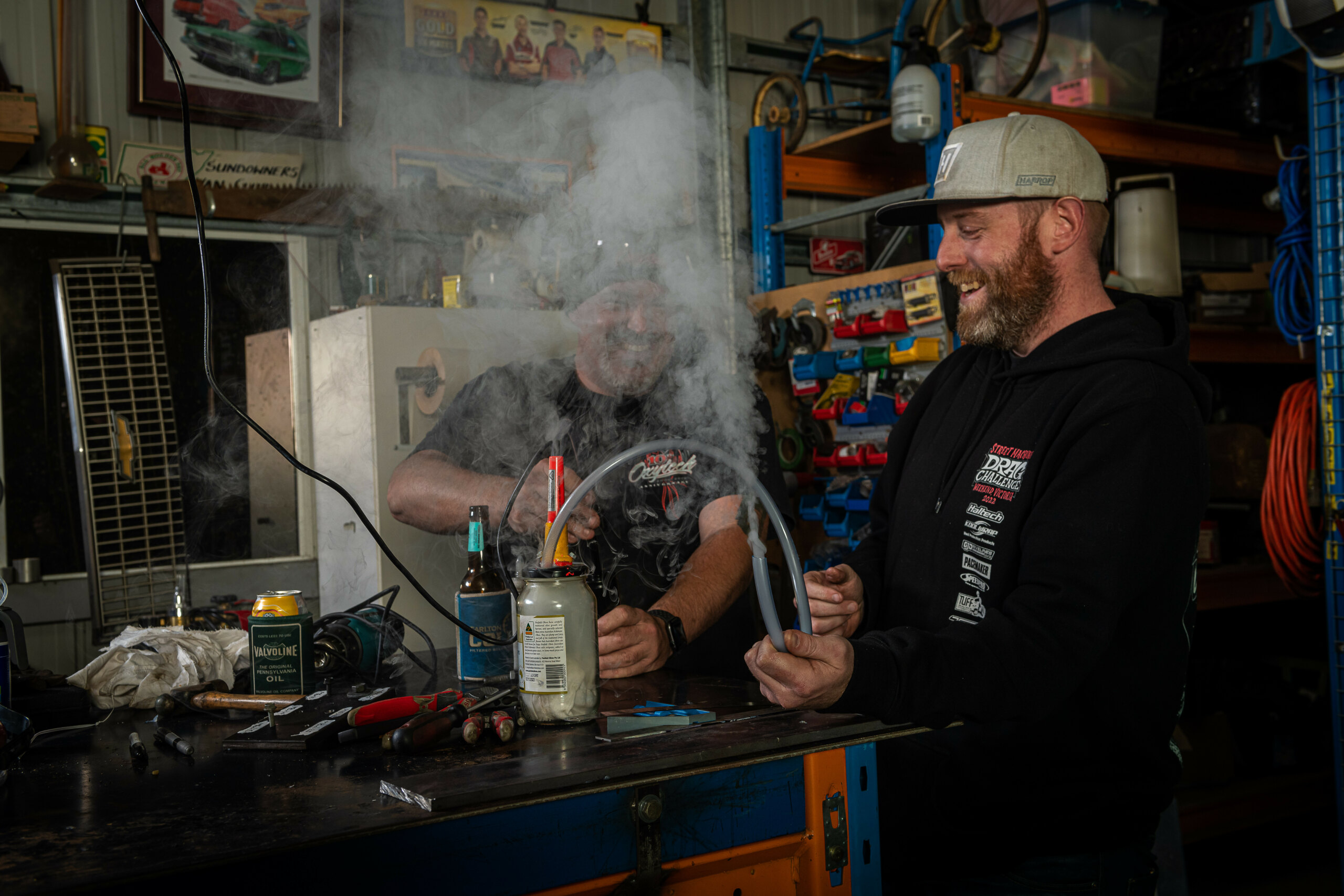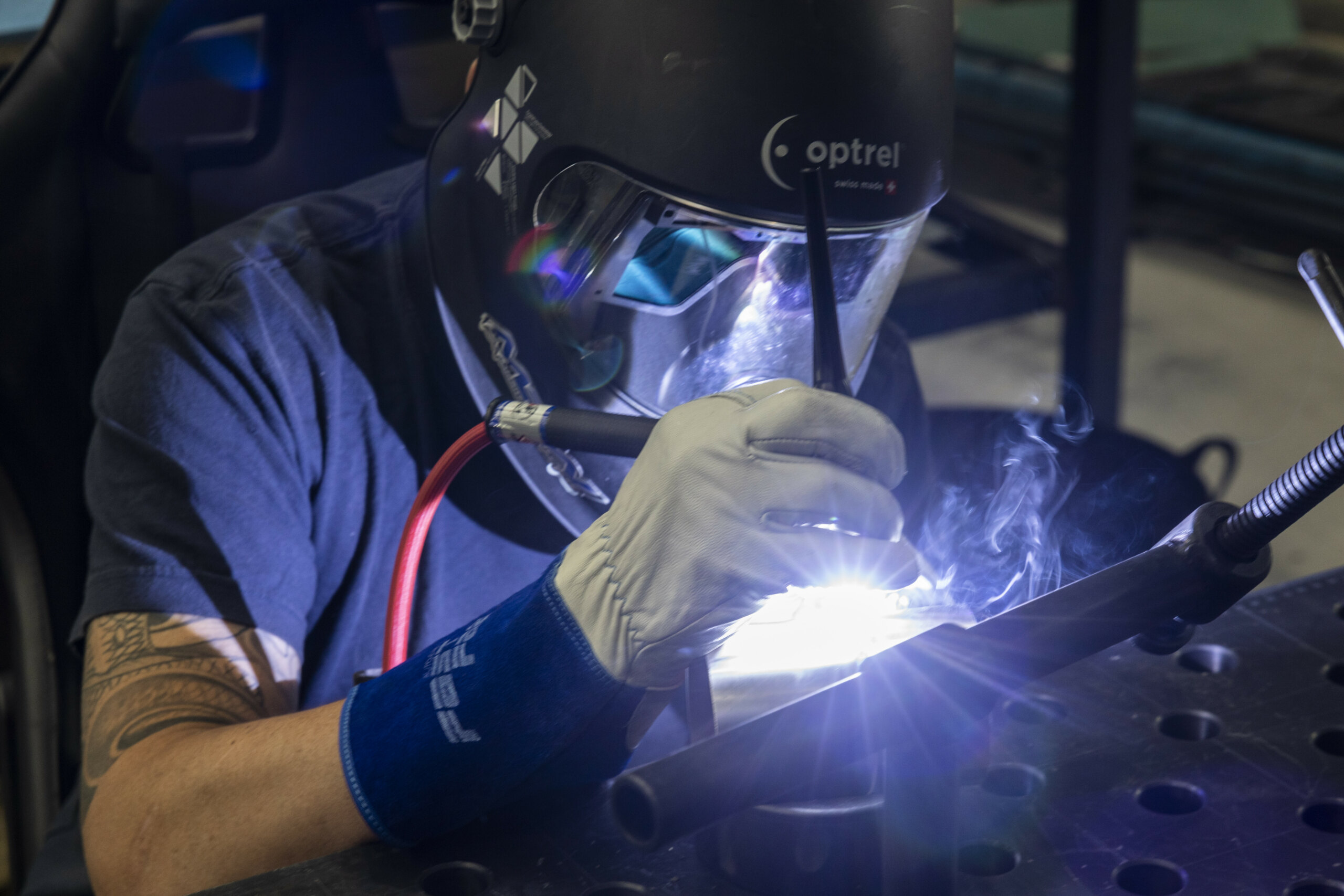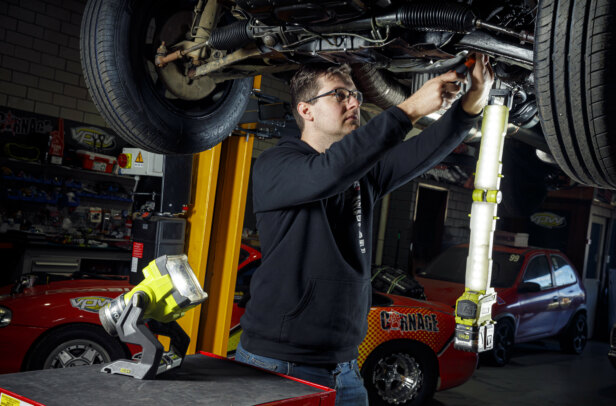We’ve all winced at those photos and videos online of somebody giving themselves a nasty injury while working on cars. I’ve got form in that regard myself – as a young bloke, I famously squished the edge of my tockley with a Valiant Hemi cylinder head!
So it’s with the voice of painful experience that I humbly offer you some tips on how to stay safe while wrenching away on your project car. Many of these may seem like common sense, but sometimes it’s the thing you least expect that can have the most serious long-term ramifications.
First published in the January 2023 issue of Street Machine
SAFETY TIPS
Keep it clean
Most of the accidents I’ve seen over the years have been due to working in a messy environment, so make sure you keep your shed clean and tidy. Set things up so that there aren’t extension leads, parts, tools or other trip hazards lying around, and make sure you have enough room to move around comfortably.
Mop up any fluid spills as soon as possible. It will all add up to a safer, more productive and more enjoyable working environment.
Unplug
Disconnect your car’s battery every time you’re doing anything more involved than a simple oil change.
Not only will it prevent accidental sparking due to dropped tools, or shorting on the starter motor or alternator, but it will also stop electrical system damage should you need to break out the welder for more serious repairs.
Support system
Never – and I mean never – get underneath a car that’s supported only by a trolley or scissor jack – or any type of jack, for that matter. Jacks can and do fail, and the results can be fatal.
This isn’t just an old wives’ tale, either; I’ve seen this happen many times in my day job over the past two decades.
On guard
Keep all guards and shields in place. Ignore what all those YouTube shows tell you; guards and shields are there for a reason, so use them, especially on grinders. Having a cutting disc explode at a zillion rpm will more than likely hurt like hell.
Most tools have adjustable guards as well, so angle them correctly for maximum efficiency. I went guardless once while cutting some water pipe; the grinder jammed and kicked back at me, and the blade sliced through my boardshorts literally millimetres from my wedding tackle! I’m sure you’re beginning to sense a theme here…
Tool right
Use tools correctly and for their intended purpose. Both hand and power tools can inflict serious damage on your soft parts if used incorrectly. Screwdrivers might make for great chisels, but they can easily break, and while hitting two hammers together might seem like a perfectly safe thing to do, I can guarantee you it’s not.
Let power tools and their respective attachments work at their own speed; forcing blunt drill bits or pushing cut-off wheels beyond their capabilities can see things quickly turn pear-shaped.
Hold your fire
It’s probably not the best idea to blow yourself up or set yourself on fire, and it’s easier to do than you might think. Many automotive tasks involve flammable liquids or materials, so whether you’re just changing your fuel filter, dropping a fuel tank out or moving flammable liquids around the shed, keep your lit durry well away and avoid showering anything volatile with sparks or the like.
Vapours are often more flammable than the flammable items themselves, so be especially careful of open ignition sources and static electricity when filling or shifting empty or near-empty flammable-item containers. Keep yourself and these containers properly grounded. Wear rubber-soled shoes, and move drums using a rubber-wheeled trolley – whatever you do, don’t roll them along on their side.
It’s also easy to lose track of your surroundings while welding, so make sure you stop regularly and look around to make sure you haven’t set yourself, your car or anything else on fire.
General electric
Make sure your electrical tools and equipment are in a safe operating condition, and keep them away from wet areas and flammable gases and vapours. I once tripped the safety switch at home after my midsummer sweat dripped into a buzzing grinder.
Most houses will have a safety switch nowadays, but it’s good insurance to have a proper Residual Current Device (RCD) nestled in your shed fuse box, or run your power tools through a portable safety pack – just in case.
Stay alert
Feeling crook, hungover or rapidly becoming three sheets to the wind? We all enjoy a beer or three in the shed, but fatigue and general distraction can quickly see things take a bad turn if you’re not properly focused on the task at hand.
Good concentration and safety go hand-in-hand, so if your mind really isn’t on the job, it’s best to close things up for the day, or choose a simpler, more mundane task that’ll keep you out of harm’s way by default.
Learn stuff
Know how to safely carry out a particular task. It might seem un-Australian to read instructions or workshop manuals, but prior to doing a job for the first time, it’s a good idea to ask any mates in the know for advice, or spend a few minutes on the Google or YouTube to get some pointers about how it’s done and what tools you may need.
Just ask anybody who has zipped apart a MacPherson strut assembly on a bench without using a spring compressor, or disconnected the tailshaft on an unchocked vehicle that uses a transmission park brake and subsequently rolls away.
Move it
Use the right tools and equipment to help get a job done safely. This is pertinent for both your immediate safety and your long-haul good health.
Engine cranes, for example, are not just great for plucking out donks; they, along with wheel dollies equipped with a ratchet strap, are also handy for shifting engines and other heavier items like transmissions and diffs around your shed.
Manually lifting and carrying such items will take its toll on backs and knees of all ages, and dropping one can quickly convert your big toe into a pikelet.
PERSONAL PROTECTIVE EQUIPMENT
Eyes
It is a scientific fact that high-pressure squirts of fuel and carby cleaner – not to mention tiny pieces of flying metal – are sexually attracted to the human eyeball, and your servo sunnies aren’t going to be up to the job of protecting your precious orbs. Safety glasses are cheap as chips, so buy a few pairs.
Better still, go for proper safety goggles and full face shields that offer the best protection. And another hot tip: replace the bloody things when they get scratched or kicked along the floor too many times, so you can actually see what you are doing.
Ears
Hearing loss isn’t something you tend to think about when you are young and dumb, but take it from me, it isn’t much fun when you get older. So, wear some decent earmuffs or earplugs when you’re grinding, sanding or using air tools.
You’ll find they’ll help reduce fatigue, and you can always keep wearing them long after the job is done for some well-earned peace and quiet!
Face
You might think your hand-eye coordination is on-point, but shutting your eyes at the same time as striking the welding torch will eventually be mistimed and your peepers will feel like they’ve been filled with sand.
Best to invest in a quality welding mask that’s tailored for your intended welding type, adjusts to your head correctly, and will hold said adjustment for the duration of your weld time. Many of the cheaper ones require constant nip-ups to stay snug on your melon, which can be annoying.
Feet
While it is tempting to work in thongs, closed-toed shoes are much better. Boots are even better still, with steel-caps the ultimate. Decent footwear not only helps reduce the hurt when you stub your toe or drop a socket set on your foot, but protects against nasty spills and burns, too.
Oh, and make sure you wear decent socks, as I guarantee that a welding or grinding spark will find its way between your boot and naked foot and have you dancing the Nutbush in no time.
Hands
Gloves are a total must in the shed, not only to protect your hands from heat and damage, but to keep yourself clean, too. I find the tighter, mechanic’s-style gloves to be the best, as they enable the maximum amount of finger feel.
However, I also rate a box of snug-fitting disposable rubber gloves for general work and staying tidy – especially when repacking wheel bearings or needing to hold something while spray painting. Don’t be afraid to chuck the fabric ones through the wash to remove any skank before the next shed session – just maybe when the missus isn’t home.
Skin
Not every job will be in the shade or protection of your shed, so if you’re working outdoors, be sure to follow the ‘slip, slop, slap’ motto: slip on a suitable shirt, slop on some sunscreen at regular intervals, and slap on a hat.
It doesn’t take long to feel the heat, especially if you’re spending a few hours on the sander or working hard with the pressure cleaner, and the sun’s UV strength can still give you a touch-up even on a cloudy or overcast day.
Clothes
Be sure to dress for the occasion, whether it means slipping on a proper welding jacket to guard against intense heat, or a quality pair of long sleeves and pants for a day on the grinder.
Wearing suitable clothing will help protect your skin from sunburn-like heat damage and spark-rash, not to mention possible exposure to spills and the like. Don’t touch or lean against stuff you’ve just cut off with an oxy, either.
Hair
This is sadly not quite the issue it used to be for those of us who are now somewhat, er, follicly challenged, but if you’re a bloke still able to sport a glorious mane, or a similarly equipped lady, be sure to securely tie your hair back, unless you want to test its tensile strength around a drill press or another quickly spinning apparatus. It’s a possible fire hazard, too.
Apart from all that, it can be just plain awkward; just wait until you’re rolling around under a car and your hair wraps itself around the wheel of your creeper.
Phone
Although often a distraction when you’re trying to make headway in the shed, your mobile phone may just be instrumental in saving your life one day.
There’s an ‘emergency contacts’ option on most phones that you can set up to automatically call emergency services, a partner, a family member or a mate by tapping a couple of buttons. Google how to set this up on your own device, but be sure to actually keep your phone on your person or within easy reach in case something goes awry. This may seem like overkill, but a lot of people have died working alone.
Lungs
The dust from sanding an old paintjob or fumes from chemicals or welding can be a danger in themselves, so be sure to work in a well-ventilated area. If you’re really hardcore and have a bit of extra coin to throw around, invest in a mask with a ventilator set-up. Masks and respirators come in a variety of grades and applications, so be sure to pick out the one that is best suited to the job at hand.
WORKSHOP ESSENTIALS
Fire extinguisher
A couple of decent fire extinguishers are the cheapest insurance you’ll ever buy. However, make sure you get the right type and ensure that they are in-date. Whether you’re using them for your workshop or even in your car, spend a couple of minutes each month to check your extinguishers’ serviceability on the charge dial, and give them a decent shake to mix up the contents.
First aid kit
While it is tempting to just wrap a sliced hand in race tape and keep working, the nature of our hobby produces quite a dirty working environment – just ask anyone who has picked up a a serious hand or foot infection from shed work. You can never have too many Band-Aids and bandages, and be sure to keep a stock of saline and eye-flush bottles, antiseptic cream and tweezers.
Fuel & oil cabinet
It’s good to keep tabs on any dangerous or flammable materials or liquids you may have, which is why a lockable yet breathable storage cabinet is a must. The general rule of thumb is to position it at least three metres from the nearest ignition source, preferably in a dedicated outdoor location.
A storage cabinet is not just to keep things organised and give you peace of mind; it will also keep away inquisitive hands and mouths of people – whether young or old – who may be unaware just how dangerous these materials can be. On that note, keep the lids on properly and be sure to clearly mark any potentially dangerous materials you transfer into jerry cans or the like.
Lights
It should go without saying that you’ll need suitable lighting so you can clearly see what you are doing and be more alert to a possible danger. There are plenty of super-bright, quality LED and more traditional lighting options out there, and you can’t go past decent portable work lamps or even a headlamp for both safety and ease of working, especially in a more confined environment.
Axle stands
Blocks and bricks may have once been the go, but decent-quality, sturdy axle or jack stands are common and affordable nowadays, and are a must for any home workshop. I personally have a set of four of both the low- and high-base ratchet-style stands; which one I use depends on the type of vehicle.
It is also handy to have these extra stands for jobs like propping up out-of-car differentials, or as a gearbox support between the front crossmember and transmission bellhousing of an engine-less ride. However, not all axle stands are created equal; ensure they are Australian Standards-approved, with the wide-base options being the most stable.
Jacks
Forget the smaller jacks for anything more serious than changing a wheel; a wide-track trolley jack with a 3000kg rating will do all manner of jobs easily and safely, and will lift your car high enough to easily position larger jackstands correctly. If manoeuvring a standard steel jack is difficult for you, lighter-weight, aluminium-style jacks are a good alternative, and they’re getting cheaper.
But make sure they have a stable design and are properly rated. Single front-wheel race jacks might look cool, but their narrow tapered design can make them unstable if not used solely on solid, flat ground. Don’t forget to invest in a couple of quality non-slip wheel chocks, too, to keep things stable during the jacking process.




Comments